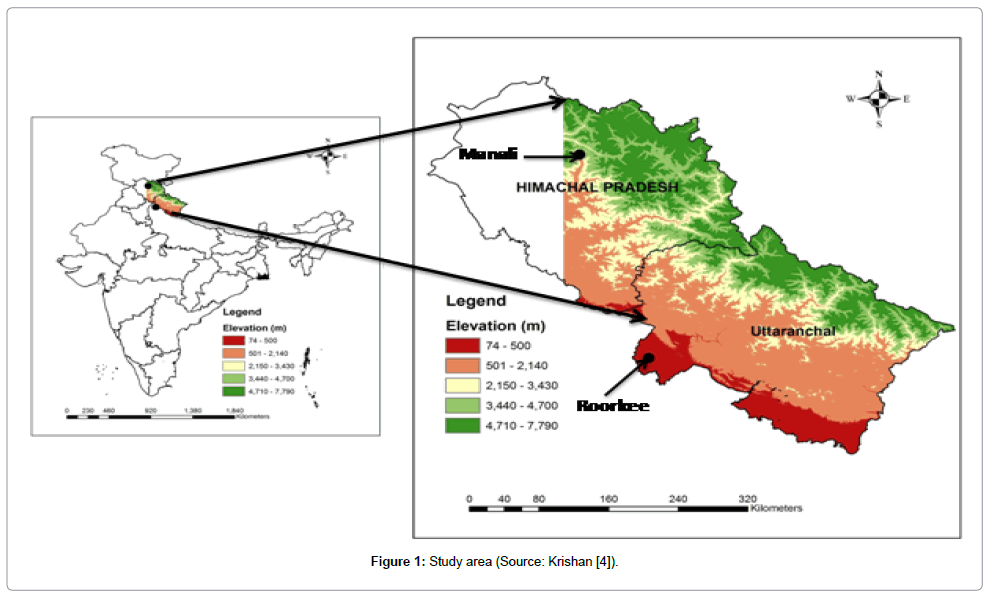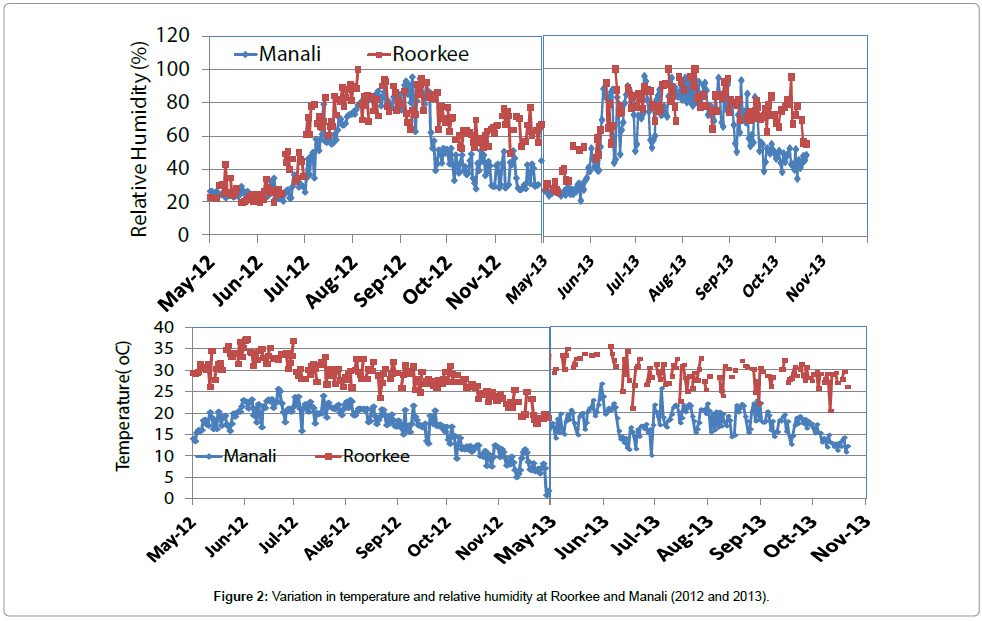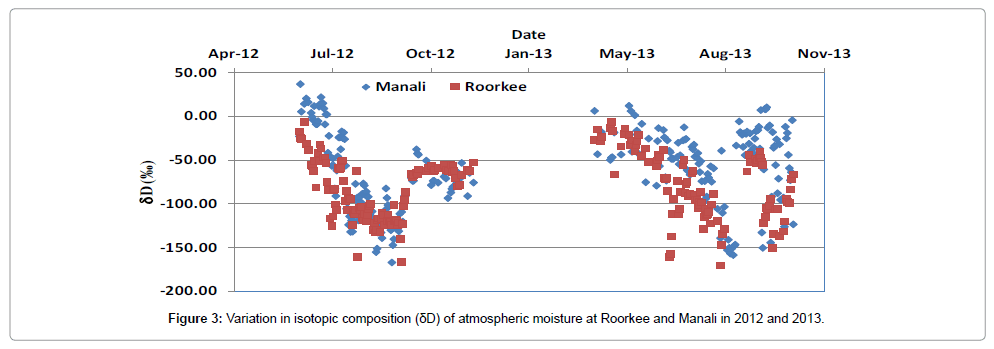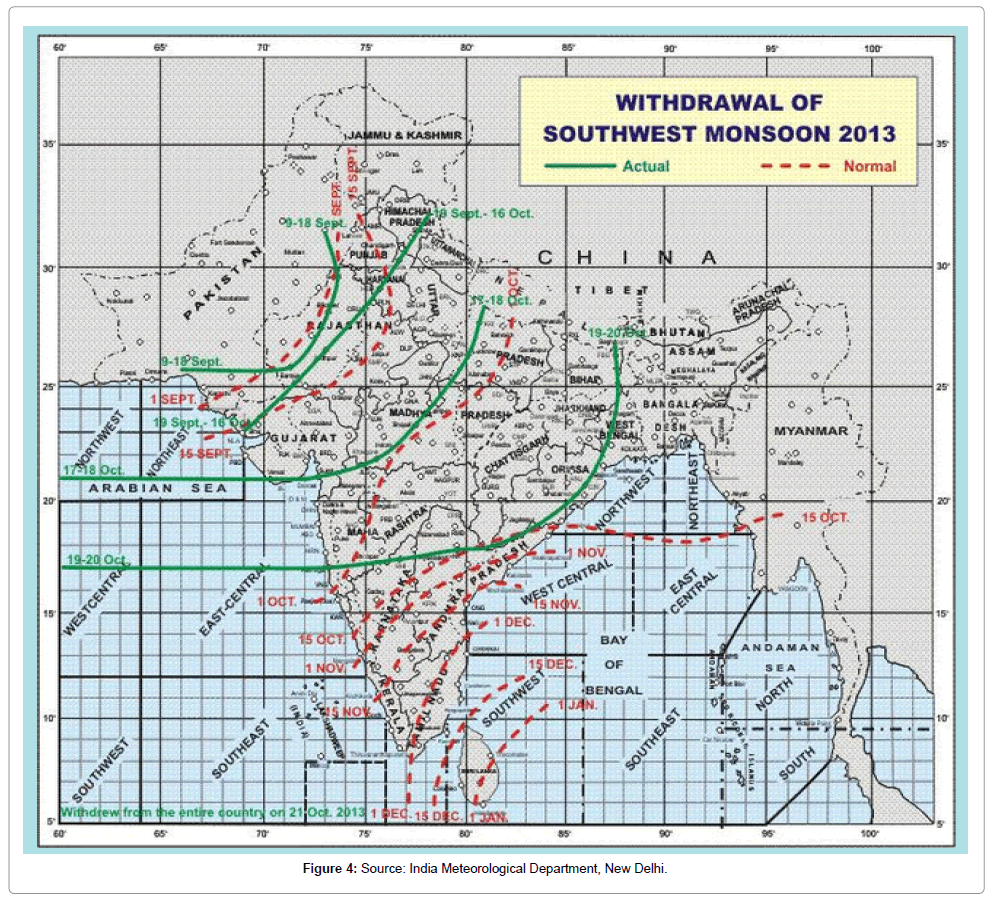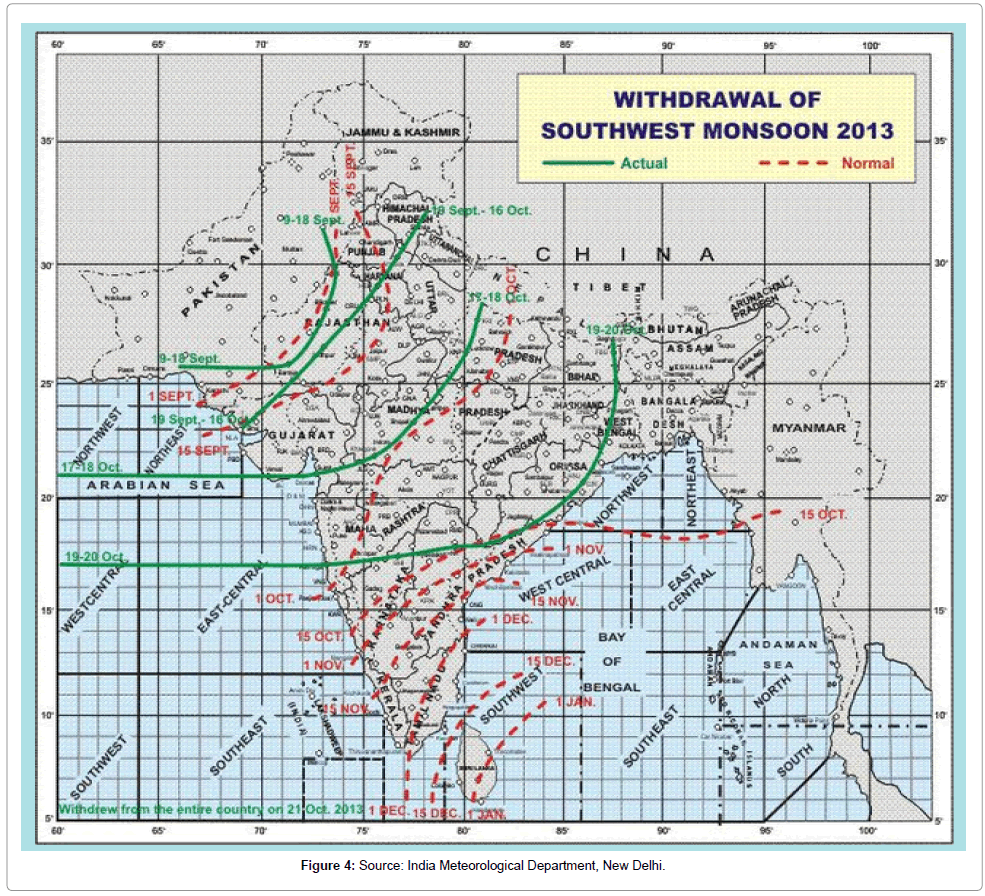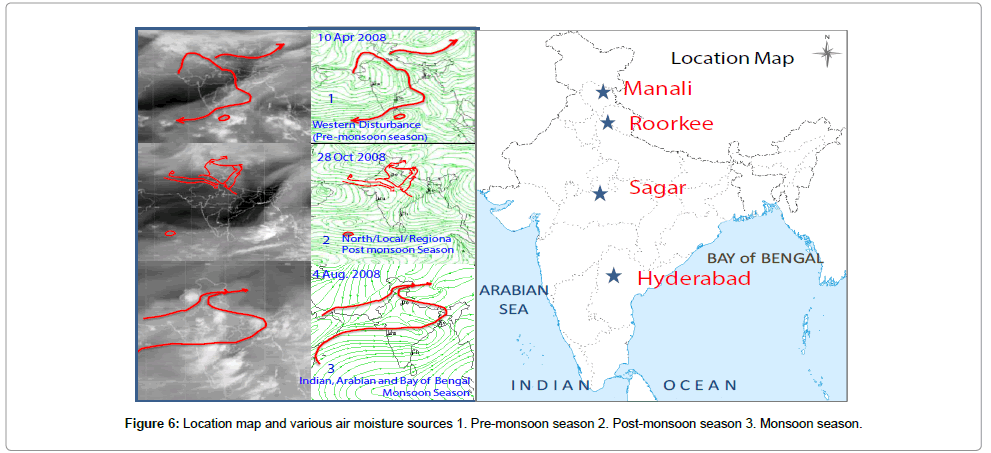Isotopic Observations from Two Stations of North India to Investigate Geographical Effects on Seasonal Air Moisture
Received: 08-Jan-2014 / Accepted Date: 23-Jan-2014 / Published Date: 29-Jan-2014 DOI: 10.4172/2157-7617.1000180
Abstract
Air moisture samples were collected from 2 stations of north India for the years 2012 and 2013: one located in high Himalayas inMarhi, Manali, Himachal Pradesh and second in Indo-gangetic plains of Roorkee, Uttarakhand using condensation method for studying seasonal variations in isotopic composition. In high Himalayas, the air moisture was found isotopically more enriched (δD) as compared to the moisture collected in Indo-gangetic plains. But due to the arrival of oceanic vaporduring the monsoon season, the isotopic values start getting depleted whichopens up the possibility to use isotopic composition of air moisture for seasonal studies.
Keywords: Air moisture; Stable isotopes; Himalayas; Indo-gangetic plains; Geographical effects
Introduction
As water passes through the hydrological cycle, there is a systematic mass-dependant partitioning of the three isotopomers1H1H16O, 1H2H16O and 1H1H18O among solid, liquid and gaseous phases which makes the heavy stable isotopes of oxygen and hydrogen (18O and 2H) useful tracers of climatological and hydrological processes. The isotopic composition of precipitation provides a conservative tracer for the origin, phase transitions, and transport paths of water. The variations in 18O/16O and 2H/1H ratios of meteoric precipitation are dominantly controlled by (i) atmospheric parameters such as temperature, relative humidity, and evaporation and (ii) geographic factors such as altitude, latitude, moisture source, and transport process.
The isotopic composition of atmospheric water vapor has a direct effect on precipitation which is primarily controlled by the processes like the trajectories of the water vapor transport over the continents and the average rainout history of the air masses. But the main factor controlling stable isotope variation of atmospheric water vapor might be different in different regions [1-6]. Therefore,observation of stable isotope variation of atmospheric water vapor has an important significance to indicate the moisture origins and moisture transport. Using the isotopic signatures of water molecules, it is possible to track the movement of air moisture as the air moisture heavy isotopes get systematically depleted [7,8] and the recycling of moisture due to condensation and subsequent evaporation cause a difference in relative enrichment in deuterium and oxygen isotopic composition and found useful in studying climatological conditions [9]. In coastal China, a few case studies on this philosophy were examined [10,11].
In the present study, change in isotopic composition of atmospheric moisture at two stations, one located in high Himalayas (Marhi, Manali, Himachal Pradesh) and other in the Indo-gangetic plain (Roorkee, Uttarakhand) is examined in order to understand isotopic variability and its link with monsoon dynamics in the region.
Study Area
The sampling station Roorkee is located in the foot hills of Shiwaliks in the north western part of the Indo-Gangetic plains falling under the latitude 29°52’, longitude 77°53’ and altitude 268m whereas, Marhi, Manali is located in the mountains of the Indianstate of Himachal Pradeshfalling under the latitude 32°19’, longitude 77°10’ and altitude 3000m (Figure 1). The normal rainfall of Roorkee and Manali is 1156.4 mm and 1363.8 mm per annum, respectively. Out of the total annual rainfall 86% at Roorkee and 52% at Manali is recorded during southwest monsoon period (June to September). Snowfall in the Manali region, which usually took place in the month of December, has been delayed over the last fifteen years to January or early February. Due to the heavy snow no sampling is possible from December to April at Manali. The monthly average maximum temperature range observed 20.4 (Jan) to 39.2 (May) and 6.1 (Jan) to 24.9 (July) where as minimumtemperature range varied 10.6 (Jan) to 27.2 (July) and -1.7 (Jan) to 15.3 (July) for Roorkee and Manali, respectively.There is a difference of approximately 3°C temperature in Roorkee and Manali during January to June and it reduced to approximately 1.5°C during July to December. The normal monsoon onset date for Roorkee and Manali is around 25th June, while the normal monsoon withdrawal date for Roorkee and Manali is around 26th September.
Figure 1: Study area (Source: Krishan [4]).
Methodology
The air moisture samples, for isotopic analysis, are collected on daily basis by condensation method [12] at the same time and using similar sampling protocols at both the stations. The date, time, temperature and relative humidity are recorded using thermohygrometer [12].Stable isotopes (2H or D) in water were analyzed using GV-Isoprime Dual Inlet Isotope Ratio Mass Spectrometer. 400 μl of the water sample is equilibrated with H2 along with Pt catalyst at 40°C for 3 hours and the gas is introduced into the mass spectrometer. The measured values are reported as delta (δ) values [13]. The precision of measurement for δ 2H is ±1‰.
Results and Discussion
Roorkee
The ambient temperatures during the sampling period at Roorkee ranged from 17.55°C to 37.35°C with an average of 28.8°C in 2012 and 20.5°C to 35.5°C with an average of 29.1°C in 2013, respectively (Figure 2), while the ambient relative humidity ranged from 20 % to 100% with an average of 60.8% in 2012 and 22.5% to 99.9% with an average of 68.4% in 2013, respectively (Figure 2).
In case of isotopic composition (δD) of atmospheric moisture, the values range from -6.3‰ to -166.0‰ with an average of -86.9‰ in 2012 and -6.4‰ to -160.6‰ with an average of -41.1% in 2013 at Roorkee, (Figure 3). At Roorkee, a depletion of 94% & 14% in 2012 and 66% and 89% in 2013, respectively in isotopic composition of atmospheric moisture during monsoon season & post-monsoon seasons as compared to pre-monsoon were found (Table 1).
| Season | Average Temperature (°C) | Average Relative Humidity (%) | Average Vapor Pressure (Kpa) | Average Absolute Humidity (g/m3) | Average dD (‰) | |||||||||||||||
|---|---|---|---|---|---|---|---|---|---|---|---|---|---|---|---|---|---|---|---|---|
| Roorkee | Manali | Roorkee | Manali | Roorkee | Manali | Roorkee | Manali | Roorkee | Manali | |||||||||||
| 2012 | 2013 | 2012 | 2013 | 2012 | 2013 | 2012 | 2013 | 2012 | 2013 | 2012 | 2013 | 2012 | 2013 | 2012 | 2013 | 2012 | 2013 | 2012 | 2013 | |
| Pre-monsoon (May-Jun) | 32.8 | 30.2 | 19.9 | 16.5 | 29 | 50.6 | 25.6 | 43 | 1.4 | 1.2 | 0.6 | 0.8 | 10.2 | 8.5 | 4.4 | 6 | -55.1 | -54.8 | -4.9 | -33.6 |
| Monsoon (Jul-Sep) | 29.1 | 28.7 | 19.6 | 18.6 | 78. 7 | 80.8 | 70.3 | 78.4 | 3.1 | 2.2 | 1.6 | 1.6 | 22.5 | 15.7 | 11.8 | 11.8 | -107 | -90.9 | -96.7 | -59 |
| Post-monsoon (Oct-Nov) | 24 | 27.6 | 9.9 | 13.6 | 63 | 72.9 | 38.4 | 45.6 | 1.9 | 1.9 | 0.5 | 0.7 | 13.8 | 13.8 | 3.7 | 5.4 | -62.9 | -104 | -68.8 | -58.5 |
Table 1: Seasonal variation on Meteorological parameters and isotopes (δD) at Roorkee and Manali (2012 and 2013).
Manali
The ambient temperatures during the sampling period at Manali ranged from 1°C to 25.8°C with an average of 16.9°C in 2012 and 10°C to 26.8°C with an average of 17.2°C in 2013, respectively (Figure 2), while the ambient relative humidity ranged from 20.5 % to 95.5% with an average of 48.7% in 2012 and 21.5 % to 95.5% with an average of 57.3% in 2013, respectively (Figure 2).
In case of isotopic composition (δD) of atmospheric moisture, the values range from 37.1‰ to-166.6‰ with an average of -74.8‰ in 2012 and 12.3‰ to -78.9‰ with an average of -30.7‰ in 2013 (Figure 3). At Manali, a depletion of 1873% & 1304% in 2012 and 76% & 74% in 2013, respectively in isotopic composition of atmospheric moisture during monsoon season & post-monsoon seasons as compared to premonsoon were found (Table 1).
As evident from the Table 1, all the meteorological parameters (temperature, relative humidity, vapor pressure and absolute humidity) at Manali for both the years 2012 and 2013 have lower values than that of Roorkee due to prevailing metrological conditions at higher altitude in Himalaya. The ambient temperature at both the stations for the year 2012 shows a declining trend from pre-monsoon to postmonsoon season, while in 2013, it showed a declining trend at Roorkee but in Manali the ambient temperature increased from pre-monsoon to monsoon season and it again decreased in post-monsoon season. The ambient relative humidity found to increase in monsoon season due to the increased moisture flux caused due to onset of southwest monsoon at both the stations during the years 2012 and 2013. With the withdrawal of monsoon the ambient relative humidity decreased at both the stations. This trend of the ambient average temperature and relative humidity putting an impact on the vapor pressure and absolute humidity as both these parameters showed an increase of approximately 100% in monsoon season at both the stations.
The enriched δD values of air moisture at Manali as compared to Roorkee during pre-monsoon season are mostly due to increased local contribution of δD into to atmosphere at Manali through evaporation/ sublimation process taking place at low temperature which prevails at higher altitudes.
The normal onset of monsoon date at Roorkee and Manali is June 25 and withdrawal date is 25 September but in 2013, the monsoon arrived by June 16 (as per India Meteorological Department, New Delhi) with an advancement of 9 days and the monsoon departed with a delay of 15 days (Figure 4).Due to the shift in arrival and departure dates we also found the following changes in comparison to the year 2012: (i) decrease in ambient temperature in all seasons at Manali and in premonsoon and monsoon seasons at Roorkee (ii) increase in average relative humidity for all the seasons (pre-monsoon, monsoon and postmonsoon) at both the stations(Roorkee and Manali) in 2013 due to increase in moisture flux as a result of onset of southwest monsoon (iii) decrease in ambient vapour pressure and absolute humidity at Roorkee and increase in ambient vapour pressure and absolute humidity at Manali (iv) enriched isotopic values of air moisture at Roorkee during pre-monsoon andmonsoon seasons, however depletion was observed in post-monsoon season; depleted isotopic values of air moisture to the tune of 88% was found at Manali in pre-monsoon season which could be attributed to the 68% increase in average ambient relative humidity. In 2013, 39% enriched values for air moisture isotopes are found in monsoon and 14% in post monsoon seasons at Manali in comparison to 2012. This could be possible due to the change in variation in air moisture sources which needs further investigations.
In general, the percent depletion in the isotopic composition (δD) of air moisture was found more at Manali than at Roorkee during the monsoon & post-monsoon period due to the contribution of oceanic monsoon vapour at Manali subjected more to continental and altitude effects than the oceanic monsoon vapour at Roorkee. However, in 2013 the percent depletion in post-monsoon season is more in Roorkee as compared to Manali may be due to delay in withdrawal of monsoon by 15 days.
Comparison of Roorkee V/s Manali data (2012-2013) with Roorkee V/s Sagar and Roorkee V/s Hyderabad data (2008-10)
On comparing the present data of Roorkee V/s Manali in 2012- 2013 with Roorkee V/s Sagar [2] & Roorkee V/s Hyderabad data (2008-10) [5], it is found that the average depletion of 781% in δD at Roorkee; 6403% at Sagar (Figure 5) and 921% at Hyderabad (Figure 5) is found during monsoon season as compared to Pre-monsoon season during 2008-10. The average depletion of 1589% (Table 1) was found at Manali during 2012-13 in monsoon season as compared to premonsoon season. Among all the stations, the highest average depletion (6403%) in the isotopic values of atmospheric vapor during monsoon season is found at Sagar due to the highly enriched isotopic values of atmospheric vapour originating from recycling of the vapor from local sources during pre-monsoon season.This was followed by the depletion (1589%) at Manali due to the moisture originating from the local sources i.e. evaporation/sublimation process in glaciated areas. However, a very good correlation between the isotopic data of Roorkee and Hyderabad is found i.e. 68% for δD due to this integrated effect of common source of moisture and partially nullifying effects of continental and altitudinal depletion in isotopic composition that similar isotopic changes are observed at both the places in various years.
As the monsoon advances, the associated isotopically depleted moisture moves along with it. Ultimately, with the withdrawal of monsoon from the Indian sub-continent the isotopically depleted vapor also gets withdrawn from the sub-continent. In the post monsoon, the evaporation of precipitated vapor from the moist surface leads to progressive enrichment till the onset of next monsoon or regional influx of moist air through Western Disturbances etc (Figure 6). Due to seasonal and air moisture source variation, the atmospheric air moisture isotope data can also be utilized for weather and climate change predictions [14].
Conclusion
The isotopic composition (δD) was found to be more enriched in atmospheric moisture samples collected during pre-monsoon period from Himalayan region due to the contribution moisture from the local sources i.e., moisture generated due to evaporation/sublimation process in glaciated areas. However, it starts getting depleted in the monsoon season due to arrival of oceanic vapor subjected to continental and altitude effects. The isotopic composition of water vapor shows a good correlation in time domain, inferring clearly monsoon signals and opens up the possibility to use isotopic signature of atmospheric moisture for monsoon studies. The isotopic composition of vapor associated with monsoon is always depleted in comparison to non-monsoon vapor due to different sources of origins and various other factors; therefore, isotopes can be used to track the movement of monsoon vapor and prediction of seasonal rainfall. Due to seasonal and air moisture source variation, the atmospheric air moisture isotope data can also be utilized for weather and climate change predictions by developing an understanding of hydro-meteorology.
Acknowledgement
This work was carried out under the project “National Programme on Isotope Fingerprinting of Waters of India” and authors are thankful to DST-SERC (funded by DST vide IR/54/ESF/05-2004 dated July17, 2007) for sponsoring the study. Authors thank Director, National Institute of Hydrology for his kind support and encouragement. Authors thank M/s. Sai Engineering Foundation, Shimla and project engineer Manish Sharma and his team for providing logistic support in taking samples at their site Marhi Mini Hydel Electricity Project, Marhi, Manali, HP. Authors like to thank the unknown reviewers for their useful suggestions and helping in improving the quality of the manuscript.
References
- Deshpande RD, Gupta SK (2008) National programme on isotope fingerprinting of waters of India (IWIN). In: Glimpses of Geosciences Research in India, Indian National Science Academy: New Delhi, India.
- Krishan G, Rao MS, Jaiswal RK, Kumar B (2012) Southwest (SW) monsoon dynamics study in Indo-Gangetic plains using isotopic techniques. J Geol Geosci 2: 2.
- Krishan G, Rao MS, Kumar CP, Kumar B, Thayyen RJ (2013) Using Stable Isotope (d) of atmospheric water vapor in southwest monsoon studies. NDC-WWC J 2: 18-20.
- Krishan G, Rao MS, Kumar CP, Kumar B (2013) Comparison of isotopic composition of atmospheric moisture within and outside Himalaya-An implication in studying monsoon dynamics. In: Proceedings of an International conference “India Water Week 2013-Efficient Water Management: Challenges and Opportunities", New Delhi, India.
- Rao MS, Krishan G, Kumar B, Anitha M, Kumar KB, et al. (2012) Stable Isotope Systematics of Atmospheric Vapor at Hyderabad and Roorkee. Int J Earth Sci Engg 5: 1123-1128.
- Rao MS, Krishan G, Kumar CP, Tripathi S, Kumar B (2013) A Pre feasibility study of isotopes for investigation of monsoon dynamics. NDC-WWC J 2: 5-9.
- Krishan G, Rao MS, Garg P, Kumar CP (2012) An investigation on continental scales and altitude effect on isotopic composition (δD) of Ground Level Vapor (GLV). In: Proceedings of an International conference on “Annual Water Resources Association-AWRA”, Jacksonville, Florida, USA.
- Krishan G, Rao MS, Kumar B (2012) Application of Isotopic Signature of Atmospheric Vapor for Identifying the Source of Air Moisture-An Example from Roorkee, Uttarakhand, India. J Earth Sci Clim Change 3:126.
- Krishan G, Rao MS, Kumar B (2012) Study of climatological conditions using isotopic signature of air moisture at Roorkee, Uttarakhand, India. NDC-WWC J 1: 5-9.
- Xue-Fa W, Shi-Chun Z, Xiao-Min S, Gui-Rui Y, Xuhui L (2010) Water vapor and precipitation isotope ratios in Beijing, China. J Geophys Res 115.
- Liu WJ, Liu WY, Li PJ, Gao L, Shen YX, et al. (2007) Using stable isotopes to determine sources for fog drip in a tropical seasonal rain forest of Xishuangbanna, SW China. Agri Forest Meteor 143: 80-91.
- Krishan G, Rao MS, Kumar B (2011) Instrumentation for measurement of isotopic composition of air moisture. J Inst Soc Ind 41: 217-220.
- Coplen TB (1996) New guidelines for reporting stable hydrogen, carbon, and oxygen isotope-ratio data. Geochim Cosmochim Acta 60: 3359-3360.
- Krishan G, Rao MS, Kumar B (2014) Isotope analysis of air moisture and its applications in hydrology. J Clim Weather Forecas 2: 1.
Citation: Krishan G, Rao MS, Kumar CP, Kumar B (2014) Isotopic Observations from Two Stations of North India to Investigate Geographical Effects on Seasonal Air Moisture. J Earth Sci Clim Change 5: 180. Doi: 10.4172/2157-7617.1000180
Copyright: ©2014 Krishan G, et al. This is an open-access article distributed under the terms of the Creative Commons Attribution License, which permits unrestricted use, distribution, and reproduction in any medium, provided the original author and source are credited.
Share This Article
Open Access Journals
Article Tools
Article Usage
- Total views: 14329
- [From(publication date): 2-2014 - Apr 27, 2024]
- Breakdown by view type
- HTML page views: 9931
- PDF downloads: 4398

